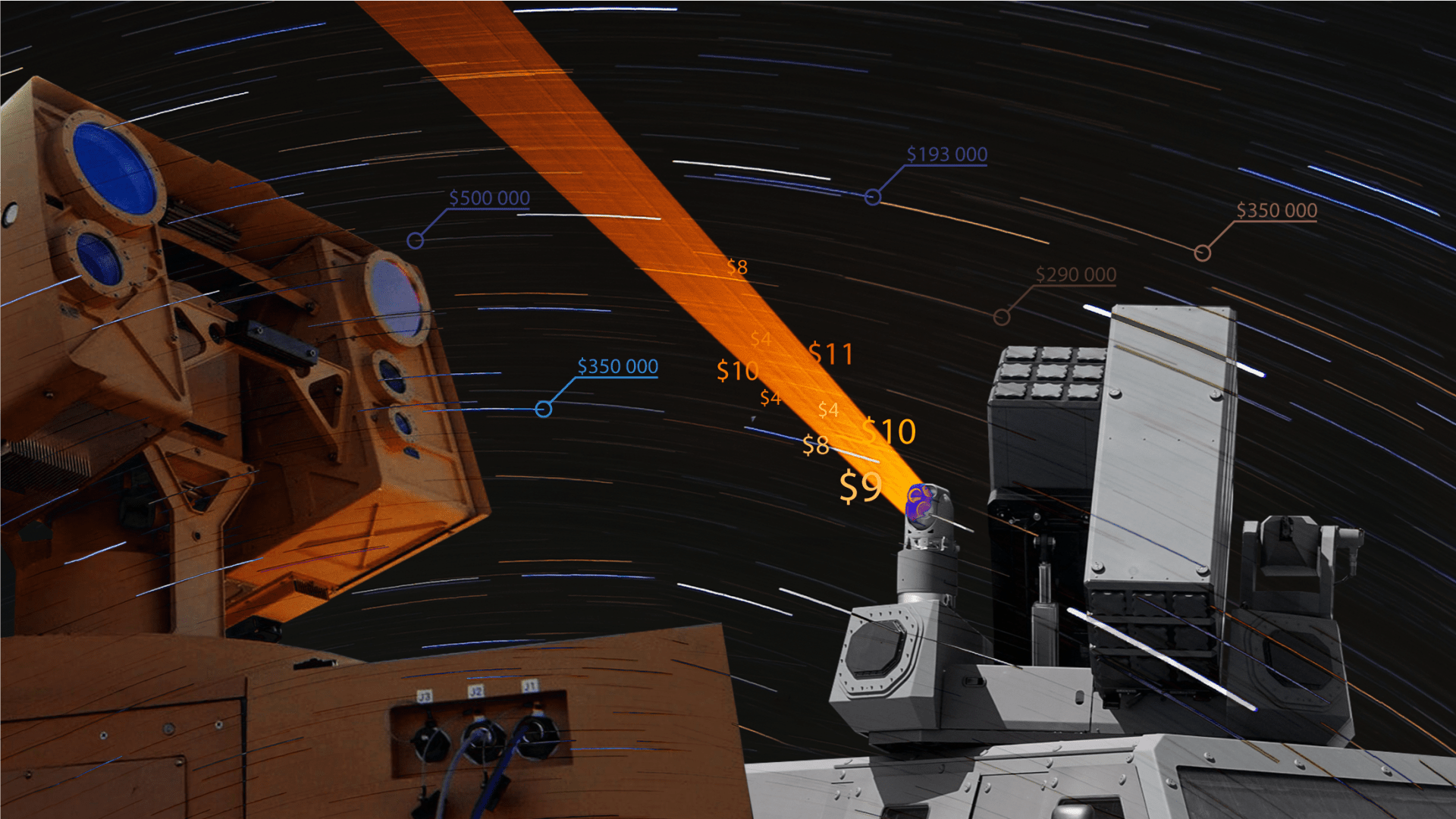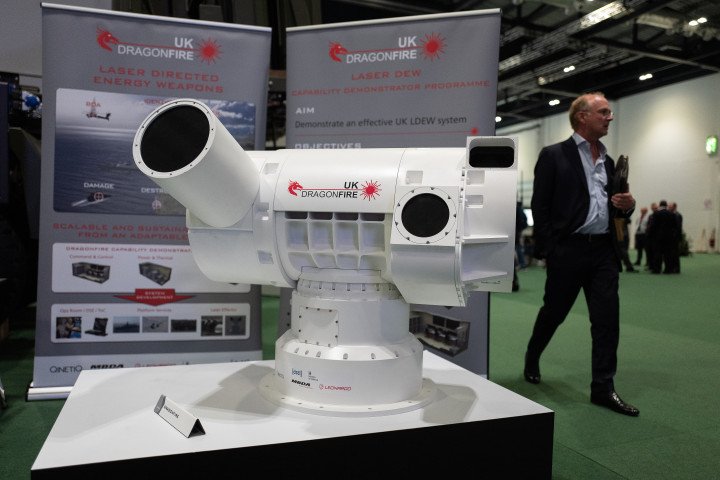- Category
- War in Ukraine
Can Ukraine Benefit from Anti-Aircraft Laser Weapons?

Once only found in the world of science fiction, laser-based weapons have become a reality in the rapidly evolving modern battlespace. What laser-based weapons are there and how effective could they be for Ukraine?
The world is locked in a high-stakes arms race, modern warfare is constantly evolving, and laser weapons are set to redefine frontlines. Nations worldwide are developing laser-directed energy weapons (LDEWs) capable of missions in the air, on land, and at sea as an alternative to costly missile-based air defense systems.
Military defense developers are determined to establish laser use in weaponry for several reasons. LDEWs can engage targets at the speed of light, defeating threats faster than the time it took to read this sentence. Its intense beam can cut through a target, leading to structural failure or destruction.
Lasers have been used in industrial processes for several years to cut, heat, vaporize, melt, and burn a variety of materials. The US has been testing LDEWs for decades and have been fitted onto several warships for trials and evaluation.
A key advantage of LDEWs is that the laser has an infinite magazine that can keep firing as long as there is electricity, but guns and cannons that fire missiles have a finite amount of ammunition. And these are often costly.

The Aster 30 missile that arms the SAMP-T air-defense system costs around $2 million per missile. Though hugely effective, it's one of the most expensive missiles in the world. However, LDEWs operate at an extremely low cost for a single shot, some just a few dollars, others, almost nothing.
Russia continues to threaten Ukraine with low-cost weaponized drones and aircraft that launch sizeable attacks against civilian and military objects, and LDEWs are being specifically for these kinds of targets.
“Low-cost drones and rockets have swung the economic calculus of offense and defense in favor of those using large volumes of cheap unmanned systems and munitions to overwhelm more sophisticated air and missile defenses,” James Black, assistant director of defense and security for the RAND Europe think tank said.
Britain's Ministry of Defense has shown footage from tests of the DragonFire long-range laser weapon.@DefenceHQ says that such advanced weaponry can "fundamentally change the battlespace."
— Anton Gerashchenko (@Gerashchenko_en) March 12, 2024
Ukraine is ready to take and test the operation of such a laser complex in combat… pic.twitter.com/EI11lr0gRZ
What laser anti-aircraft weapons are there so far?
P-HEL
This year marked the first publicly known deployment of a laser-based system for air defense in military history. The US military has been successfully using its first deployed system since November 2022, and its second earlier this year, according to BlueHalo, the US defense contractor of the Palletized High Energy Laser (P-HEL).
The US has not confirmed where the P-HEL was sent but the service’s top acquisition official has confirmed its operational success in the Middle East.
DragonFire laser
A new air protection laser defeated 100% of threats during recent live-fire trials. It’s been designed to fit a range of RAF aircraft and can rapidly detect and defeat incoming missiles.
— Ministry of Defence 🇬🇧 (@DefenceHQ) October 20, 2024
The system has been developed by @Leonardo_UK @ThalesUK and @dstlmod pic.twitter.com/5pUT0jCeAR
British Royal Air Forces “are one step closer to being equipped with a cutting-edge laser self-protection system, following 100% successful live-fire trials” the UK Government announced on October 20, 2024.
The DragonFire is an LDEW system and “a potential game changer for air defense,” former Defense Secretary John Healy said.
Its range is currently classified but this line-of-sight weapon engages with any visible target, and its precision is equivalent to hitting a £1 coin from a kilometer away.
Firing it for 10 seconds is the cost equivalent of using a regular heater for just an hour, typically around 13 dollars or £10 per shot.
Sources report that the DragonFire will be in the hands of the British Navy from 2027.
“Identifying, tracking, and defeating threats from the air in seconds is crucial to having the edge over those who try to do us harm,” Healy said.
Block-I
Big news.
— ハク Mason (@mason_8718) July 11, 2024
South Korean government has unveiled the 'Laser based Anti-Aircraft Weapon Block-I' for the first time, and it's awesome footage. it's about to deploy it to the Army very soon.
It's a 20kW class fiber laser system with a proper size and cost that can be placed easily.… pic.twitter.com/AIl4ZUJrWY
South Korea has begun production of its new LDEW, called Block-I. This low-cost-to-fire weapon “can precisely strike small unmanned aerial vehicles (UAVs) and multicopters at close range,” South Korea’s Defense Acquisition Program Administration (DAPA) said.
Block-I is being produced for the Armed Forces of South Korea and costs only around $1.5 for a single shot. Its rays are nearly impossible to detect and just like the DragonFire, it’s operated as long as electricity is available, the DAPA said.
The current version focuses on the elimination of small UAVs but DAPA is already looking at developing the Block-II system. It would be a more advanced version of the Block-I, potentially capable of taking out bigger targets, including aircraft and ballistic missiles, “with improved output and range compared to the current one.”
DAPA said that Block-I has also had a 100% success rate during live-fire tests.
Iron Beam
It's a technological breakthrough as RAFAEL's High-Power #Laser Air Defense System "Iron Beam" successfully intercepts an array of airborne threats. Watch for yourself here: pic.twitter.com/6QAy8Fjodd
— Rafael Advanced Defense Systems (@RAFAELdefense) April 14, 2022
The Iron Beam, just like the DragonFire and Block-I, has an unlimited magazine with “almost zero cost per interception..quickly and effectively engaging and neutralizing a wide array of threats from a range of hundreds of meters to several kilometers, ” their producer Rafael wrote. Rafael is the producer of Israel's infamous “Iron Dome ”.
The Iron Beam works by heating the target in vulnerable areas, including its engine or warhead until the projectile ceases. Each shot costs around $3, compared to the upwards of $40,000 for each Tamir missile used in Israel’s Iron Dome air defense.
Israel’s defense ministry said that they expect to be using the Iron Beam laser defense system within a year, noting that the laser weapons will bring “a new era of warfare” as they engage with drones and missiles from Iran and neighboring countries.
Rafael also announced their new LITE BEAM laser weapon system. It is “engineered for swift and accurate neutralization of aerial threats, including drone swarms” and “is a game-changing system enabling protection of forces in the land maneuver” they announced on X.
Bringing “Star Wars” to Reality: Meet LITE BEAM, RAFAEL’s cutting-edge 10kW-class High Energy Laser Weapon System. Engineered for swift and accurate neutralization of aerial threats, including drone swarms, LITE BEAM delivers unparalleled precision and cost-efficiency, setting a… pic.twitter.com/qtFTQ0CEEf
— Rafael Advanced Defense Systems (@RAFAELdefense) October 6, 2024
Lightning Protection Project
Earlier this year, Taiwan and the National Chungshan Institute of Science and Technology (NCSIST) successfully developed a 50 kW laser cannon, to be mounted on CM-32 Clouded Leopard armored vehicles. The LDEWs production has been created under the code name “Lightning Protection Project.”
NCSIST researchers, according to sources, have also discussed integrating the LDEW into AN/TWQ-1 Avenger air defense vehicles. Ukraine currently uses both the Leopard armored vehicles and the Avenger.
Testing is due to be complete by the end of this year in the hopes of integrating the LDEW into military forces.
Lockheed Martin
Lockheed Martin, military defense developers have supplied Ukraine with a variety of weapon systems such as; Javelin anti-tank missiles, HIMARS mobile artillery rockets, and PAC-3 air defense missiles, among others. Army Tactical Missile Systems (ATACMS) which have proven very effective in striking Russian military targets are also produced by Lockheed Martin.
They are also developing airborne, naval, ground, and high-power microwave-based laser systems. Very little has been published, and there is never certainty as to whether Ukraine would receive any specific Western weapon, but developments are underway. In the race for modernized weapon systems to counter air attacks, we will likely see developments from Lockheed Martin soon.
🔴Lockheed Martin's all-electric, high-energy laser weapon defeating a cruise missile in flight. pic.twitter.com/F1N0aAYGz1
— IDU (@defencealerts) September 19, 2022
Does Russia have laser weapons?
A few months into the full-scale invasion, Russia claimed that it was “using a new generation of powerful lasers in Ukraine to burn up drones, deploying some of Moscow's secret weapons to counter a flood of Western arms” Yury Borisov, the former deputy minister of defense of the Russian Federation boasted.
In 2018, Putin claimed that Russia had a laser-system called, Peresvet, which could “blind satellites up to 1,500 km above Earth.”
Borisov said that “if Peresvet blinds, then the new generation of laser weapons lead to the physical destruction of the target—thermal destruction, they burn up,” claiming that Russia is already using a laser system called Zadira—roughly translating as “bully.”
Following these claims, John Kirby, Pentagon’s spokesperson denied Borisov's statement “we don't have any indication of the use of lasers, at least weaponized lasers, in Ukraine. Nothing to confirm on that.”
The Russian claim was “more propaganda,” said President Zelenskyy, comparing it to the so-called “wonder weapon” that Nazi Germany claimed to develop during World War 2.
Since the Kremlin's claims, there is still no evidence of them using any laser weaponry, though developments can’t be ruled out.
Will Ukraine be using laser weapons in the future?
This is Raytheon's High Energy Laser (HEL) fitted to the Stryker DE M-SHORAD. Its 50 kW laser can shoot down Class I, II, and III drones at ranges > 5 km. This means small, medium and large UAS flying at altitudes of up to 30,000 ft. It can perform a C-RAM role against rockets,… pic.twitter.com/Zt8CsBmqvv
— Nicholas Drummond (@nicholadrummond) September 30, 2023
The Directed Energy Maneuver-Short Range Air Defense (DE M-SHORAD) program, according to sources, has been focusing on integrating 50kW-class laser systems onto Stryker infantry carrier vehicles (ICV).
There are already a variety of US-donated Stryker ICVs in Ukraine and more are to be delivered as part of a US military aid package. However, there has not been any announcement nor speculation as to whether Ukraine might receive the LDEWs on any of the Strykers.
Success rates from the live-fire testing done for LDEWs have proven positive.
Most of the lasers are currently developed to target drones which are undoubtedly a huge problem, overwhelming expensive air-defense systems in Ukraine.
Air defense could focus on using its prized and costly missile-based air-defense systems on larger military targets. Their extremely low-cost shots would be beneficial. Lasers would also resolve other key issues on Ukraine’s frontline such as manpower, and supplies.
Ukraine has received several military aid packages from the UK, so should they be a success for the UK military, Ukraine could certainly request these in future arsenal deliveries. However, their integration into the UK military begins in 2027, and Zelenskyy is working for Ukraine’s peace and freedom long before then.
However, Russia continues to target Ukraine’s electrical power grid causing huge disruption across the country. Ukraine has been successfully making adjustments through generators and other power sources but whether these will be sufficient to continuously power LDEWs is uncertain.
Winter is drawing in on Ukraine, and there are problems with using LDEWs in the rain or mist. Not only do the beams become weaker in adverse conditions, but they also rely on being able to attack visible targets, unlike missiles which can eliminate targets out of eyesight.
Modern warfare and its arsenal are constantly being adapted to suit specific needs. As with most weaponry, LDEWs are unlikely to be a stand-alone “game-changer”, but would likely be a success should producers ensure continuous power sources. DEWs are still fairly new, producers and developers are always working to enhance the needs in current warfare, and they certainly would already have their benefits.
Ukraine needs weapon systems now, and these are unlikely to arrive in Ukraine soon.
UNITED24 is raising funds for Ukraine's defense. Donate now to help make Ukraine safe.
-46f6afa2f66d31ff3df8ea1a8f5524ec.jpg)
-6359eca46c72bde40a90abaaadd6eaa8.png)
-29a1a43aba23f9bb779a1ac8b98d2121.jpeg)


-206008aed5f329e86c52788e3e423f23.jpg)
